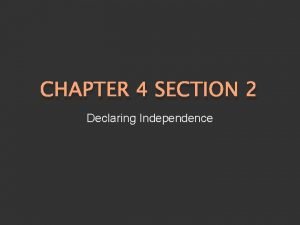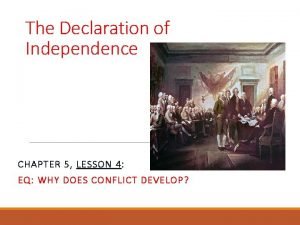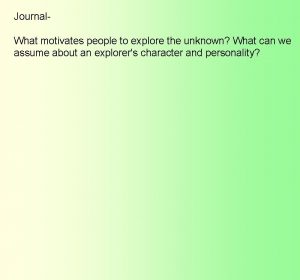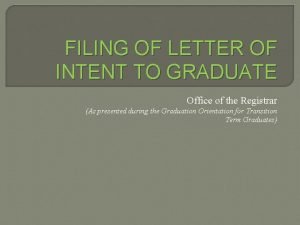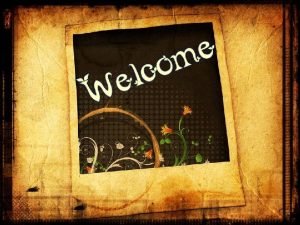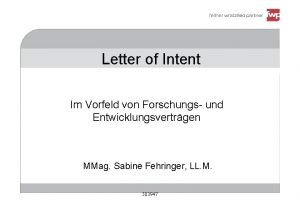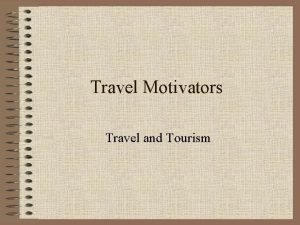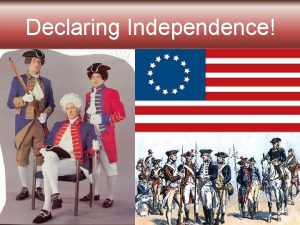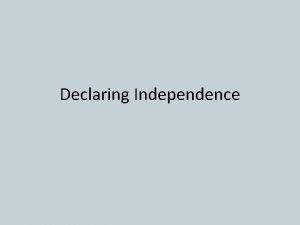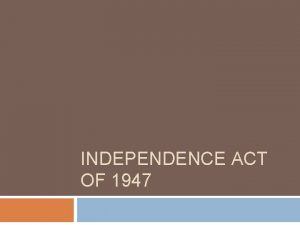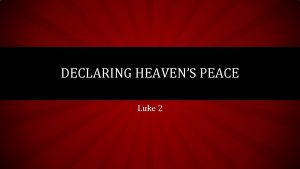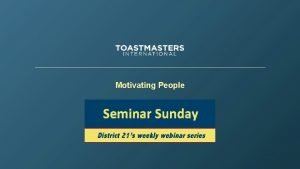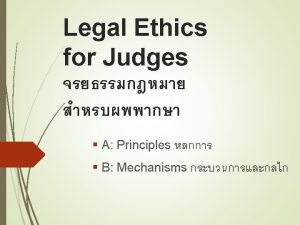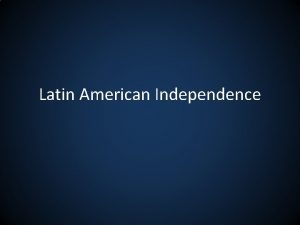Declaring Independence WHAT MOTIVATES PEOPLE TO ACT The









- Slides: 9

Declaring Independence WHAT MOTIVATES PEOPLE TO ACT?

The Second Continental Congress Guiding Question: How did individuals and events impact efforts for independence? In 1774 the Continental Congress (1 st ) agreed to meet again if the British did not address their complaints. • In fact, as the battles at Lexington and Concord in 1775 showed, the dispute between the British and the colonies had worsened.

Distinguished Leaders The Second Continental Congress met on May 10, 1775. • The delegates included some of the greatest leaders in the colonies. • Among them were John and Samuel Adams, Patrick Henry, Richard Henry Lee, and George Washington—all delegates to the First Continental Congress. • Several new delegates came as well. • Benjamin Franklin, one of the most respected men in the colonies, had been a leader in the Pennsylvania legislature. • John Hancock of Massachusetts was a wealthy merchant. He funded many Patriot groups, including the Sons of Liberty. The delegates chose Hancock to be president of the Second Continental Congress. • Thomas Jefferson, only 32, was also a delegate. He served in the Virginia legislature. Jefferson was already known as a brilliant thinker and writer. • The delegates at the Second Continental Congress had much to discuss. • Though American and British blood had been spilled, they were not ready to vote for a break from Britain. • It would be another year before Jefferson would write the Declaration of Independence.

Key Actions The Continental Congress did take steps to begin governing the colonies. • authorized the printing of money and set up a post office, with Franklin in charge. • also formed committees to handle relations with Native Americans and foreign countries. • created the Continental Army. • Unlike local militias, such a force could form and carry out an overall strategy for fighting the British. • The Congress unanimously chose George Washington to command this army. • Washington was an experienced soldier and a respected Southern planter. He left Philadelphia at once to take charge of the forces in Boston. • • • The delegates then offered Britain a last chance to avoid war. They sent a petition, or formal request, to George III. Called the Olive Branch Petition, it assured the king that the colonists wanted peace. It asked him to protect the colonists' rights. The king rejected the petition. Instead, he prepared for war. He hired more than 30, 000 German troops, called Hessians to fight alongside British troops.

The War Heats Up Congress learned that British troops in Canada were planning to invade the colonies. • Washington reached the Boston area in July 1775, a few weeks after the Battle of Bunker Hill. • The British held Boston, but Patriot militia ringed the city. • Although the size of the colonial force grew every day, Washington realized that the men were disorganized and lacked discipline—the ability to follow strict rules and procedures. • Washington began the task of turning armed civilians into soldiers. • Washington also needed weapons. • He arranged to have dozens of cannons hauled 300 mile(483 km) from Fort Ticonderoga. • Moving the heavy guns was a huge effort. In March 1776, Washington believed his army was ready to fight. Under the cover of darkness, he moved soldiers and cannons into position overlooking Boston, while the redcoats slept. • This move surprised the British, who realized they were now within easy reach of Washington's big guns. • British General William Howe commanded his soldiers to board ships and withdraw from Boston. On March 17, Washington led his jubilant troops into the city.

Moving Towards Independence Many colonists held on to hope that the colonies could remain part of Great Britain. • Still, support for independence was growing. • It was inspired in no small part by writer Thomas Paine. • Paine arrived in the colonies from England in 1774. • He soon caught the revolutionary spirit. In January 1776, he published a pamphlet called Common Sense. • In bold language, Paine called for a complete break with British rule. • Common Sense listed powerful reasons why Americans would be better off free from Great Britain. • The pamphlet greatly influenced opinions throughout the colonies.

Declaring Independence! Guiding Question: Why did the American colonies declare independence? The Second Continental Congress was filled with spirited debate: Should the colonies declare themselves an independent nation or stay under British rule? While delegates debated, Congress chose a committee to write a declaration of independence. John Adams, Benjamin Franklin, Thomas Jefferson, Robert Livingston, and Roger Sherman formed the committee. • Adams asked Jefferson to write the first draft. • Jefferson agreed that he would do the writing for the great project. • He drew on ideas from English philosopher John Locke to explain why the 13 colonies were proclaiming their freedom. • In the 1690 s Locke expressed the idea that people are born with certain natural rights to life, liberty, and property. • Locke wrote that people form governments to protect those rights, and that a government interfering with those rights could rightfully be overthrown. • Jefferson and other Patriots agreed with Locke.

On July 2, 1776, the Second Continental Congress voted on Lee's resolution for independence. • Twelve colonies voted for independence. New York did not vote but later announced its support. Next, the delegates discussed Jefferson's draft of the Declaration of Independence. • After making some changes, delegates approved the document on July 4, 1776. • John Hancock signed the Declaration first. He remarked that he wrote his name large enough for King George to read without his glasses. • Eventually 56 delegates signed the document announcing the birth of the United States. Copies of the Declaration of Independence were printed and sent out to people in the newly declared states.

The Declaration of Independence The Declaration has four major sections. • The preamble, or introduction, states that people who wish to form a new country should explain their reasons for doing so. • The next two sections of the Declaration list the rights that the colonists believed they should have and their complaints against Great Britain. • The final section proclaims the existence of the new nation. July 4, the date the delegates actually adopted the Declaration of Independence, is celebrated as Independence Day. The Declaration of Independence states what Jefferson and many Americans thought were universal principles—that is, principles that apply to all people in all situations. The Declaration announces America's new status. • Pledging "to each other our Lives, our Fortunes, and our sacred Honor, " the Americans declared themselves a new nation. • The struggle for independence—the American Revolution—had begun.
 Chapter 4 section 2 declaring independence
Chapter 4 section 2 declaring independence Lesson 4 declaring independence
Lesson 4 declaring independence What motivates people to explore the unkown
What motivates people to explore the unkown God speaks the end from the beginning
God speaks the end from the beginning Graduation fee breakdown
Graduation fee breakdown How to write a free verse poem
How to write a free verse poem Come let us sing a song a song declaring we belong to jesus
Come let us sing a song a song declaring we belong to jesus Lol declaring intent
Lol declaring intent Latin american people win independence
Latin american people win independence Travel motivators and demotivators
Travel motivators and demotivators
